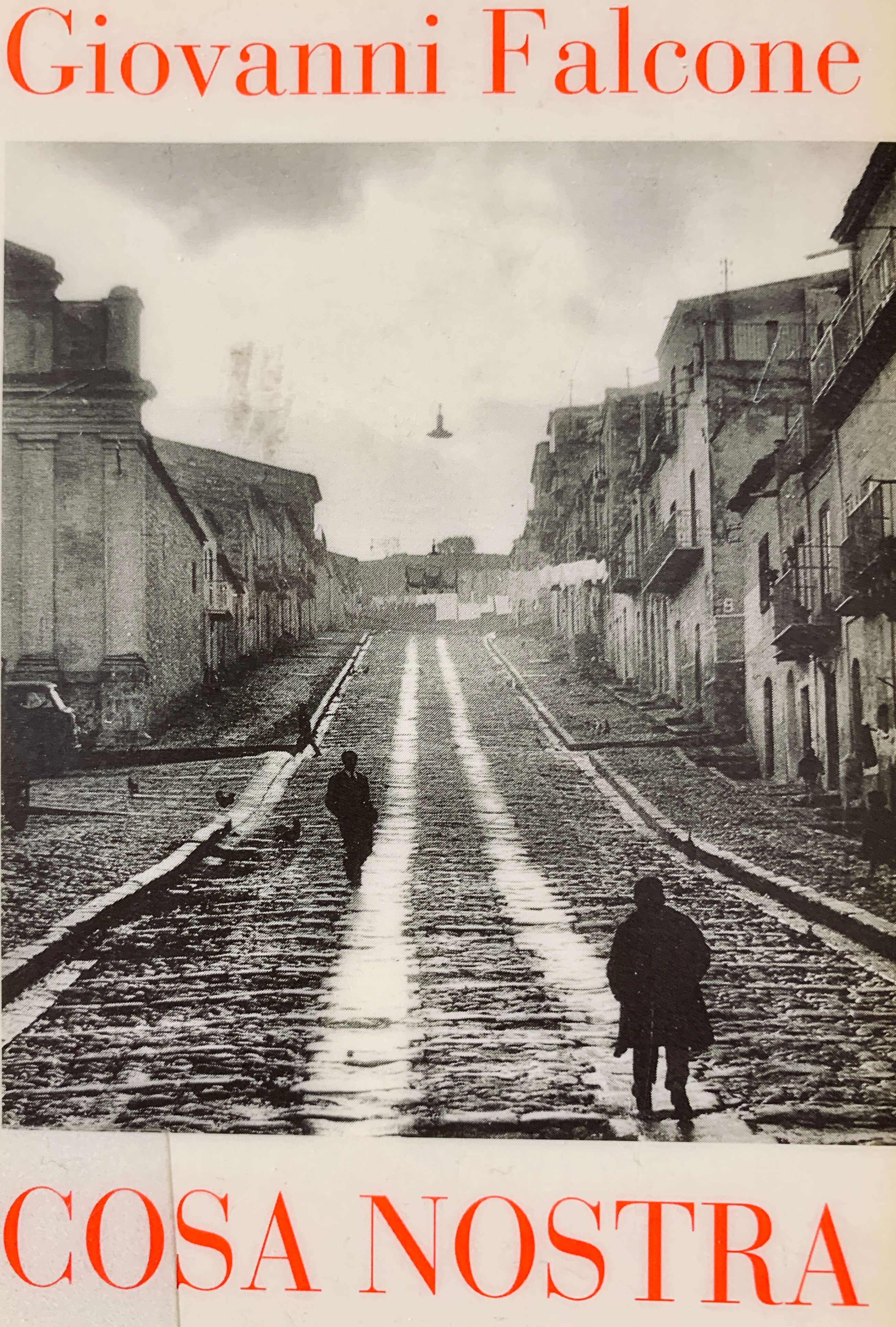- Home
- History of Sicily
- History of the Mafia
- Toto Riina
toto riina - the beast of corleone
Toto Riina was one of the most feared bosses of the Sicilian Mafia. He rose to power by killing all his rivals.
Riina's path to the top of Cosa Nostra was based on long-term brutality. That same brutality also ultimately brought him to his doom.
In public, Riina claimed to be just a poor farmer from the village of Corleone. That's also how he liked to represent himself: a simple, harmless peasant. Nothing could have been further from the truth.
Early Years in Corleone
In 1943, a bomb exploded in Corleone. It wasn't a mafia attack. It was just that Salvatore Riina's father had brought an unexploded Allied aerial bomb to his home. He had found it in a field and thought there might be something of value inside it. When he started to dismantle the bomb, it exploded.
The explosion killed Riina's father and one of his brothers. The other brother was hospitalized. Riina had become the provider for his family at the age of just 13.
Riina's childhood and youth were marked by poverty and hunger. The family depended for their livelihood on a small plot of land they owned outside of Corleone. Riina walked there every day to work the land. First with his father, then without him.
Farming, however, was not what Riina felt he was destined for. If there was one thing Riina never lacked, it was ambition. And for the ambitious young man, there was only one option in Corleone of those times—the Mafia.
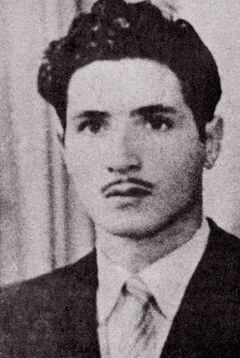 Toto Riina, a thriving young Mafioso.
Toto Riina, a thriving young Mafioso.At the time, Michele Navarra was the head of the mafia in Corleone. Following in his footsteps came a young man, the sickly but talkative Luciano Leggio. Riina and Leggio became friends.
On the night of 10-11 March 1948, Riina assisted Leggio in the murder of Placido Rizzotto, the leader of the local trade union. Rizzotto had done the worst: he had openly threatened Navarra and Leggio.
Despite eyewitness testimonies, no one was ever convicted.
At eighteen, Riina ended up in prison for the first time. It was a clash between gangs of boys. One of the opponents had pulled out a revolver. Riina took out his gun and fired several times. One of the boys was killed.
Riina was released from prison after six years in September 1955. He returned to Corleone. The old gang was still together. But now Riina's old friends, Luciano Leggio, Binnu Provenzano, and Calogero Bagarella, were no more just Navarra's errand boys. They had become full-blooded mafiosos.
Relations between Navarra and his former apprentices were becoming strained. All this led to an inevitable showdown. Navarra's men laid siege to Leggio's farm. A shootout ensued, but Leggio survived with scratches. Shortly afterward, Toto Riina disappeared underground. Something was about to happen.
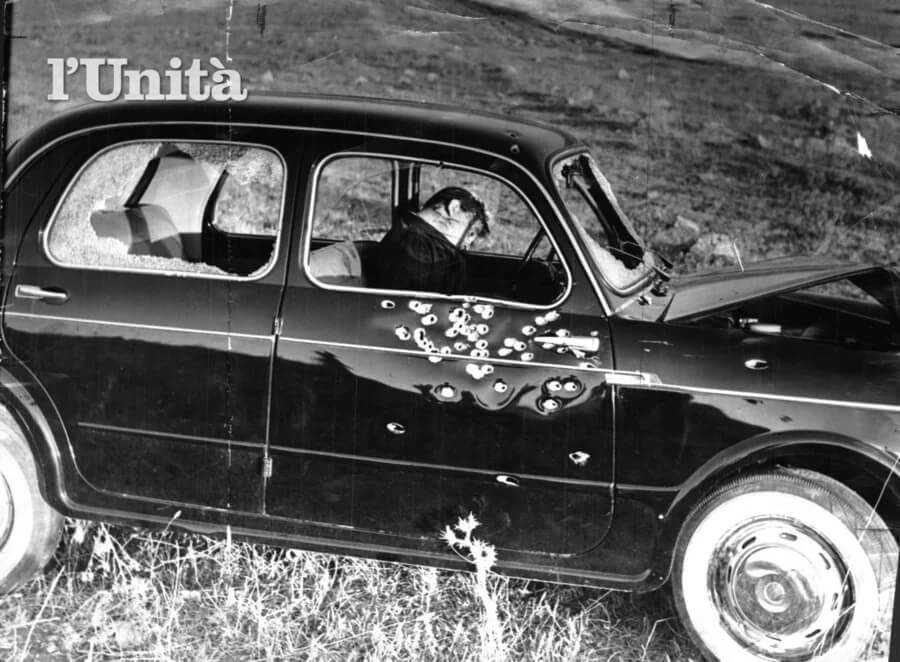 Michele Navarra's car after the shooting. Navarra has collapsed and is not seen. The man in the driver's seat is an innocent doctor who happened to be in the company of Navarra.
Michele Navarra's car after the shooting. Navarra has collapsed and is not seen. The man in the driver's seat is an innocent doctor who happened to be in the company of Navarra.A New Era Dawns in Corleone
Ninety-two bullets were found in Navarra's body. They came from five different types of guns: a Thompson machine gun, an Italian Breda rifle, and three automatic pistols. There were no eyewitnesses. Police estimated that there must have been at least seven killers, two of whom were driving cars.
Navarra was accompanied by another doctor, Giovanni Russo, who was driving a Fiat 1100, which was subsequently riddled with bullets. The murder took place on 2 August 1958, around three o'clock in the afternoon, in the countryside around Palazzo Adriano.
A five-year war followed, after which none of the late Dr Navarra's friends were left alive. After a job well done, Riina and his friends could put their shotguns away - at least for a while.
A new page in Sicilian history had been turned. The respectable old-time mafiosos were a thing of the past. The youth had arrived, thirstier than ever.
Corleonean Mafia at the Gates of Palermo
Toto Riina, Luciano Leggio, Binnu Provenzano, and Calogero Bagarella arrived in Palermo as fugitives. They were now the rulers of Corleone, but they had to stay underground.
They were peasants. Humble, respectful, even submissive. Hats in hand, they arrived. The Mafia bosses of the capital laughed at them behind their backs.
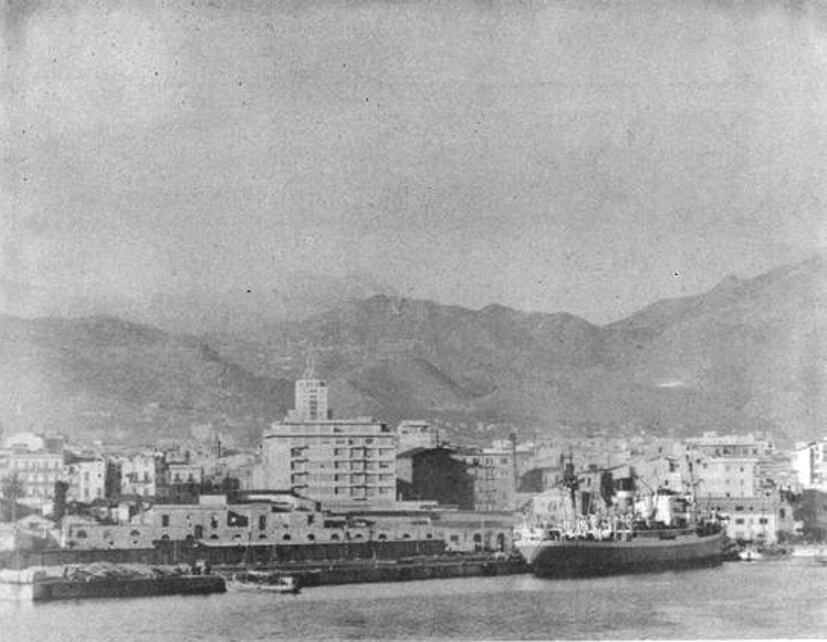 Palermo, 1957.
Palermo, 1957.Palermo was experiencing a building boom. Cosa Nostra had its hands deep in the cement on which the city was being built. Palermo's bosses moved in high circles where construction projects were decided.
In this new environment, Riina was just another mafia soldier among the others. But he had one advantage. He acted as a messenger between the new boss of Corleone, Luciano Leggio, and the bosses of Palermo. Riina had become Leggio's trusted man.
Leggio himself soon moved to northern Italy. There, he lived a life of luxury surrounded by women. It was rumored that he had gone into the drug business.
The First Mafia War
In Palermo, the Corleoneans were taken under the protection of Mafia boss Salvatore La Barbera. He provided them with hiding places. In return, the Corleoneans did odd jobs for him. Then, one day, La Barbera disappeared.
The car was found in Agrigento, the man himself nowhere to be found. The traditional 'white shotgun' case. It was a Corleonean trademark, meaning a murder with no body.
None of the bosses in Palermo knew what had happened.
Then, a car exploded in front of the house of the Greco mafia family. No one came forward as the perpetrator. The First Mafia War broke out.
Hundreds of people were killed. There were shootings all over the city. For a few months, the clans of Palermo killed each other, not really knowing why.
This ended when a car bomb exploded in Ciaculli, killing several carabinieri and police. It was 30 July 1963.
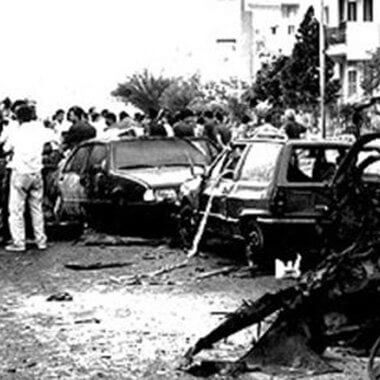 Ciaculli massacre, 1963.
Ciaculli massacre, 1963.The Ciaculli bomb angered the Italian government and its citizens. The government went after Cosa Nostra with unprecedented force. 855 mafiosos were arrested across Sicily. One of them was Toto Riina.
Riina's path led him to Ucciardone prison in Palermo. The place was known in Mafia circles as the Grand Hotel. The bosses lived there in abundance. There was no shortage of champagne, culinary delights, and good service.
Toto Riina kept a low profile. Soon, Luciano Leggio also honored the place with his presence.
Riina's time in prison was not wasted. He ate well and learned to play checkers. He was good at listening to the concerns of other prisoners, which made him a well-liked man. As was his habit, Riina was also constantly gathering information about the movements of the criminal world.
Meanwhile, life outside prison was beginning to return to normal. The memory of the Ciaculli bomb faded from people's minds. Soon, Cosa Nostra's activities went on just like before.
The Mafia Trial in Bari
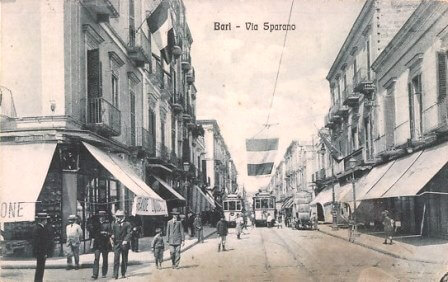 Bari is a port town in Puglia, Southern Italy.
Bari is a port town in Puglia, Southern Italy.Toto Riina and sixty-three other Corleoneans were on trial in the town of Bari, in Puglia. The reason was that the Palermo courts were not considered reliable when it came to Mafia crimes.
The charges related to a five-year mafia war. Luciano Leggio was one of the accused.
The case seemed clear. There seemed to be no doubt about the guilt of the accused. At least not until the postman walked into the courtroom. It was the last day of the hearings. The letter was addressed to the president of the court. It had been sent from Palermo.
The letter was full of typing errors. It was written in black ink and signed with a cross. The President of the Court read it silently, turned pale, wiped his sweat, and then circulated the letter to the judges and jury members.
This letter from Sicily warned against convicting 'honest Corleoneans.' If they were convicted, all the judges, jury members, and their families would be slaughtered.
The following day, all 64 defendants were found not guilty. The informant on whose witness the charges were based was found to be mentally ill and 'unprecedentedly sexually disturbed.'
The informer was sent to a prison psychiatric hospital. He was released in the 1980s, after which he was soon shot.
Toto Riina's Power Grows
The Sicilian Mafia had always been divided into two parts. There were the Palermitans - and then there were the provincial mafias. In the 1970s, the Corleoneans started gradually to take over the provinces.
Riina had a habit of gathering information on everyone and everything. He played the mafias against each other. Riina also didn't care about the "honor codes" of Cosa Nostra. He, for example, organized kidnappings and assassinations of high-ranking people, even though the Mafia had deemed kidnappings forbidden in Sicily and everybody was ordered to keep a low profile.
In the meantime, Leggio had been found and arrested. Riina's actions may have been intended to keep Leggio in prison. At the very least, they did not help the imprisoned mafiosos. Nor did Riina do anything to help Corleone's official boss to be released.
Some even say that it was Riina who gave the police an anonymous tip about Leggio's hiding place.
Riina was creating a secret network of contacts within the Cosa Nostra. He seemed to have a finger in a little bit of everything. All this was going on behind the backs of Palermo's big bosses.
However, when complaints were made to Palermo, the bosses didn't take it seriously. Something for which they would later pay with their lives.
One by one, the Palermitans lost their allies all over Sicily. Those who weren't converted to Corleonean's side were murdered.
The Second Mafia War
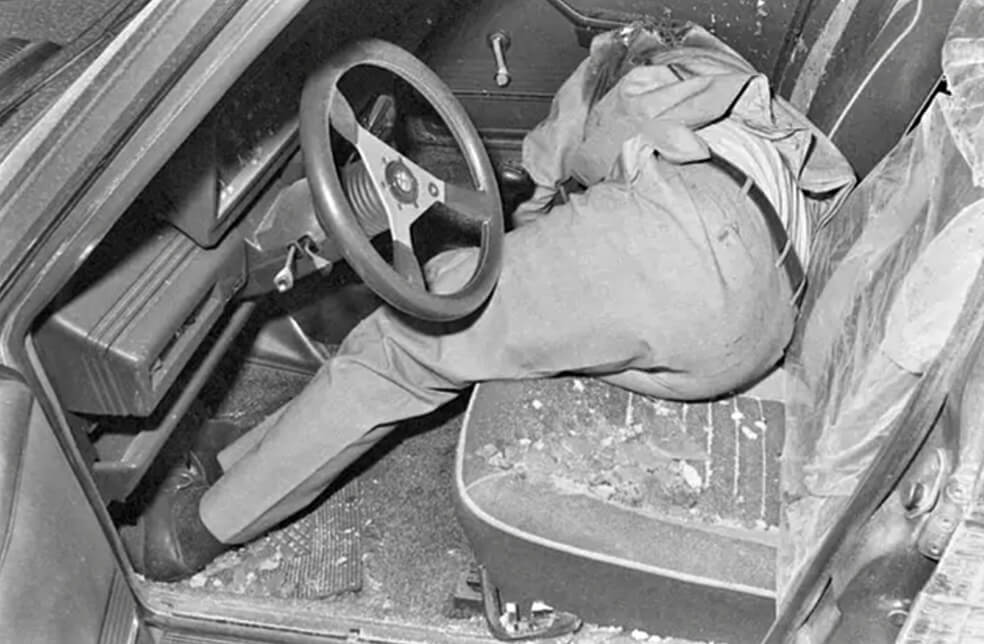 The murder of mafia boss Stefano Bontate started the Second Mafia War. Sights like this became part of everyday life in Palermo in the following years.
The murder of mafia boss Stefano Bontate started the Second Mafia War. Sights like this became part of everyday life in Palermo in the following years.On 23 April 1981, Mafia boss Stefano Bontate turned forty-two. On his way home from the party, he was shot in his car. Then, it was the turn of another boss, Totoccio Inzerillo, who was murdered on his mistress's front door.
After that, it was general slaughter all over Palermo. Anyone who refused to cooperate with the Corleoneans was killed. A mere failure to salute was enough. People were tortured, "interrogated," strangled, burned, dissolved in acid, and drowned in the sea. And not only the mafiosos but also their relatives: sons, cousins, nephews, fathers...
This period is called the Second Mafia War. But it was not a war. In a war, soldiers on both sides die; here, not a single Corleonean was killed.
During 1981, five hundred people were killed. Over the next year or so, another five hundred were killed. Nothing like this had ever been seen before. In the past, Mafia's principle had been to kill only when you have to.
Toto Riina had achieved his dream. He had finally become the top boss of Cosa Nostra. Rules, traditions, values... all that was thrown in the trash. Toto Riina had only one role to play: that of absolute dictator.
Cosa Nostra was now ruled with terror. Anyone could be killed - especially if you weren't from Corleone. Carabinieri, police, politicians, businessmen, journalists, witnesses... Riina told, laughing, that his motto was to treat a sore finger by cutting off the whole hand.
Maxi Trial in Palermo
Meanwhile, one of the biggest bosses, Tommaso Buscetta, was arrested in Brazil. He was flown to Italy after being tortured and attempting to kill himself. On the plane, Buscetta gathered enough strength to tell the police officer on board: "I want to tell everything."
And everything he did tell. The interrogator was magistrate Giovanni Falcone. To him, Buscetta revealed the whole structure of Cosa Nostra, its history, and its recent events.
After listening to Buscetta, Falcone signed 366 arrest warrants and filed 300 charges. These included new evidence of 121 murders. For the first time, Cosa Nostra was prosecuted as an organization. Until then, each case had been dealt with individually.
The trial lasted two years. The final result was 2,665 years of imprisonment and 19 life sentences. Riina and his number one gun, Bernardo Provenzano, both received life sentences. The same went for many of their associates.
Both Riina and Provenzano continued their lives on the run, as before.
Toto Riina's War Against the State
In March 1992, Riina called together four of his most loyal Mafia bosses. They met at a farm near Enna.
Riina was angry. More angry than ever before. Judge Falcone had won the fight of his life. The structure and criminal nature of Cosa Nostra had now been officially known for the first time in history.
Riina had long been trying to find weaknesses in Judge Falcone's security measures. Now, he thought he had finally succeeded. The dynamite was installed in the drainage pipe blew up the highway and the cars driving on it beyond recognition. Falcone was dead.
Fifty-seven days later, it was Paolo Borsellino's turn. He had been a close friend and a colleague of Falcone.
As always, Riina faced his problems by growing piles of bodies. Only the results were the opposite of what he would have hoped for. The murders of Falcone and Borsellino spurred the Italian state to take an even more determined approach to the Mafia.
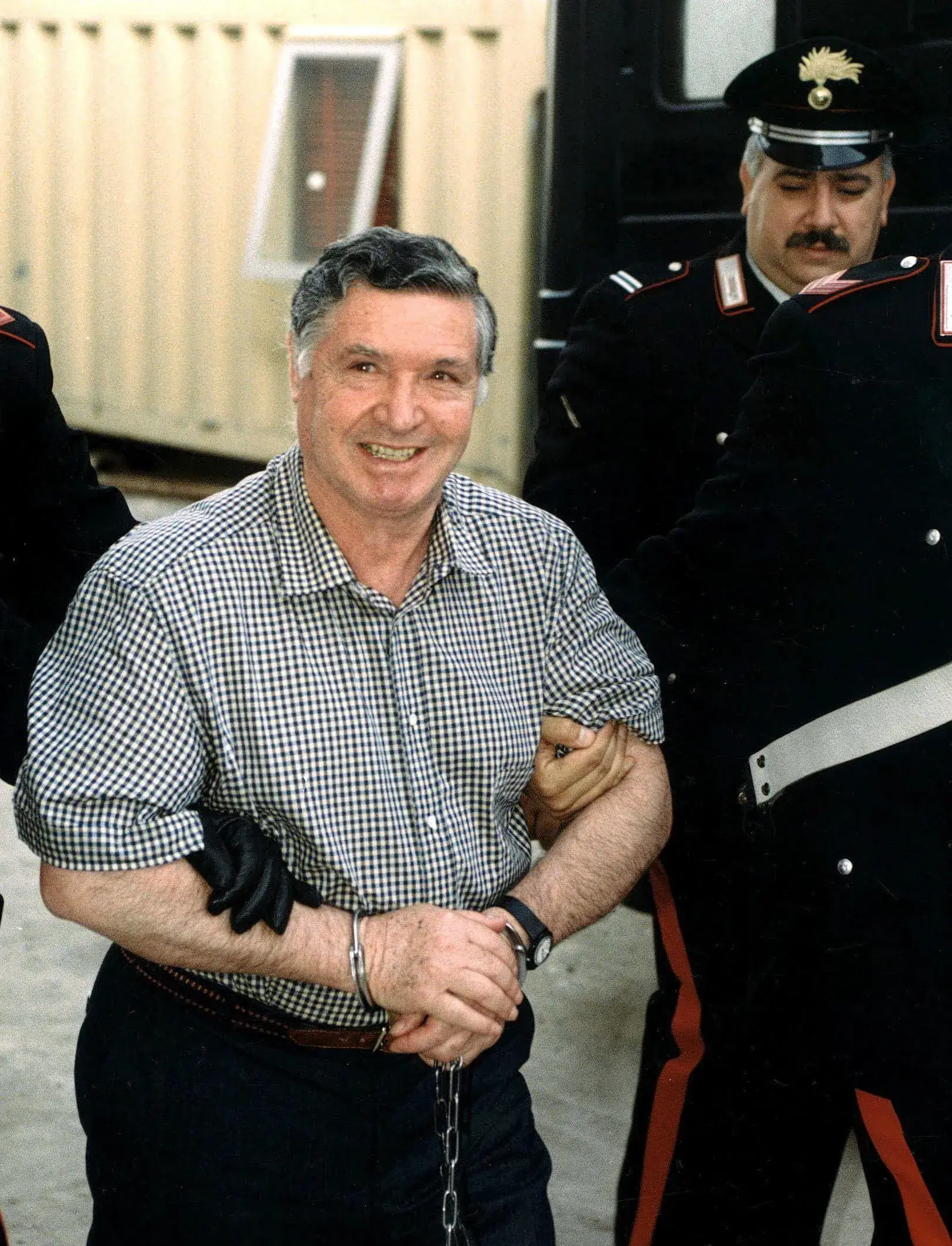 Toto Riina was captured in 1993 after 23 years on the run.
Toto Riina was captured in 1993 after 23 years on the run.Imprisonment and Death
Riina was captured in 1993. The capture was prompted by the murders of Falcone and Borsellino and the confessions of repentant mafiosos. Riina was imprisoned, convicted, and never walked free again. He died in prison at the age of 87 in November 2017.
Riina never spoke about his life or confessed to anything. In his own words, he was just a poor farmer from Corleone. Which he probably was at heart, despite all his wealth and the countless murders.
Conclusion
Toto Riina was the most brutal mafia boss Sicily has ever seen. He grew up in poverty, from which the only way out was to join the Mafia.
Riina appeared to be foolish and good-natured when in reality he was cruel and cunning. By the time the other mafiosos realized the danger, it was too late.
In the end, Riina's brutality led not only to his downfall but almost to the destruction of the entire Sicilian Mafia.
(Last edited: December 11, 2024)
Recent Articles
-
Honeymoon in Sicily: Where Landscapes Stir the Heart
Dec 17, 25 12:21 PM
Honeymoon in Sicily: Timeless temples, coastal hideaways, slow meals, and landscapes that invite closeness. -
Best Time to Visit Sicily: Your Seasonal Guide
Dec 05, 25 04:23 AM
Find the best time to visit Sicily. Explore seasonal weather, crowds, prices, and highlights. -
Where to Stay in Sicily: Top Areas for Every Traveler
Nov 27, 25 08:14 AM
Where to stay in Sicily: A guide to the island’s best regions, helping you choose the perfect base for your trip.
Follow MANY FACES OF SICILY on Facebook, Instagram, Bluesky & Tumblr
Contact: vesa@manyfacesofsicily.com
